 |
|

|
 |
TABLE of CONTENTS
 |
Changes on the St. Croix River: new Hwy 36 crossing opens, Stillwater Lift Bridge closes |
By Chris Joyce
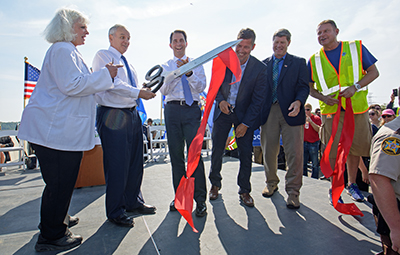
From left, Mary McComber, Oak Park Heights mayor; Minnesota Gov. Mark Dayton; Wisconsin Gov. Scott Walker; U.S. Rep. Sean Duffy; U.S. Rep. Ron Kind; and Kevin Walker, Metro District public affairs; participated in the ribbon-cutting ceremony for the St. Croix River Crossing Aug. 2. Photo by David Gonzalez |
Decades-in-the-making, the new St. Croix River Crossing is now a reality.
Minnesota Gov. Mark Dayton and Wisconsin Gov. Scott Walker cut the ceremonial ribbon marking the official end of the project on the morning of Aug. 2. The bridge opened to traffic later that evening.
The new bridge has two lanes in each direction and a multiuse trail, and spans almost one mile across the river from Oak Park Heights, Minn., to St. Joseph, Wis. It replaces the Stillwater Lift Bridge, which closed to traffic the evening of Aug. 2.
The St. Croix Crossing’s extradosed design is only the second of its kind in the U.S. It is a hybrid structure combining a cable stayed design with a segmented concrete box design. The hybrid design was chosen to ensure that the pier heights, which are 65 feet above the bridge surface, would not be higher than the bluffs along the river. It is intended to fit into the river gorge as naturally as possible.

The new St. Croix River Crossing between Oak Park Heights, Minn., and St. Joseph, Wis. opened to traffic Aug. 2. Photo by David Gonzalez |
The ceremony for the $646 million project was held on the Minnesota approach and included Wisconsin Congressmen Sean Duffy and Ron Kind, Oak Park Heights Mayor Mary McComber and St. Joseph Town Board Chairman Tom Spaniol. An estimated 2,500 people attended the event, including a few who also had been at the 1931 dedication of the Stillwater Lift Bridge.
“This new bridge reinforces the strong economic ties between Minnesota and Wisconsin, better connecting people with jobs, families, and better opportunities on both sides of the river,” said Dayton. “I thank the strong bipartisan leadership from both states that has made this project a success, supporting jobs for more than 3,000 people from Minnesota and Wisconsin over its four-year construction.”
Dayton took a good-natured jab at his Wisconsin partners, joking that Minnesota would begin building a toll booth the next day, and would “charge double everybody who has a Green Bay Packers sticker on their windshield.”
“This project provides a sorely needed new connection between Minnesota and Wisconsin,” Commissioner Charlie Zelle said in a news release announcing the bridge’s opening. “It has been a monumental effort and one that will serve the citizens of Minnesota and Wisconsin for generations.”
Many stakeholders and coalitions have been involved over the years in the St. Croix Crossing project.
“This project is a testament to what strong cooperation between states can do,” said Zelle. “The bridge is a work of art and it is also a technological marvel. Citizens in this region will be well-served for decades to come.”
Open for business
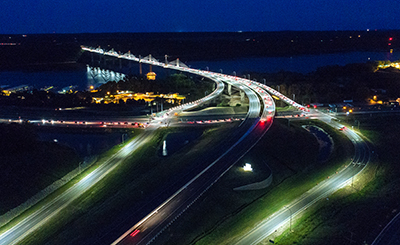
A nighttime view of the St. Croix River Crossing looking from Minnesota to the east. Photo by David Gonzalez |
Moments after 8 p.m., motorists, bicyclists and pedestrians from both sides of the St. Croix River began the journey over the new bridge. People everywhere used their cell phones to capture the historic moment.
Some had waited for hours to be among the first to cross the bridge. Three MnDOT trucks started the procession from the Minnesota side, with a ribbon of cars, pick-ups and motorcycles streaming behind. Leading the Wisconsin contingent was a red Honda SUV, roof light flashing and its driver giving a big thumb’s up as he drove past. Behind the steering wheel was a smiling Terry Zoller, MnDOT’s St. Croix Crossing project manager who, after a 45-year career, literally rode off into the sunset and into retirement.
It was a night of firsts.
On the sidewalk on the north side of the bridge, there were the first bicyclists and the first tandem bicyclists, grinning broadly as they pedaled up hill (the bridge climbs from 110 feet on the Minnesota end to 150 feet on the Wisconsin bluffs). There were the first pedestrians, two teen-aged girls in leggings and t-shirts, one of whom also claimed the title as “the first cartwheeler” as she demonstrated her skill. The first dog, a Sheltie named Harley, kept his owner moving at a good pace. There was even the first traffic jam on the bridge when the Minnesota traffic briefly backed up heading into Wisconsin.
Stillwater Lift Bridge: end of an era, start of a new one
The Stillwater Lift Bridge carried 18,000 vehicles a day between the two states before its retirement.
To honor the historic bridge’s importance to the region, the community held a “Cruisin’ to Closure Party.” The last cars to cross the 86-year-old bridge included a parade of nine vehicles—one for each decade the bridge has been open.
With the closure, MnDOT now begins a two-year project to update the Lift Bridge and convert it to a bicycle-pedestrian-only structure as part of a five-mile bike trail. The new Lift Bridge facility is expected to open by 2019.

An estimated 2,500 people attended a ceremony for the opening of the St. Croix River Crossing Aug. 2. Photo by Doug Thies |
|
 |
|

|
 |
TABLE of CONTENTS
 |
Success comes in all sizes, MnDOT awards its first contract using a Small Business Contract Preference |
By Mary McFarland Brooks

Faith Crump, Cross Cultural Business Resources, LLC, owner, listens to Ashanti Payne, Office of Civil Rights, speak at an I-35W/Lake St. DBE networking event. Crumpís business was the first to be awarded a contract under the Small Business Contract Preference. Photo by David Gonzalez |
MnDOT awarded its first project using a Small Business Contract Preference July 7 to the certified Targeted Group business, Cross Cultural Business Resources, LLC. The legal authority for this type of contract has been in place for many years under Minnesota Statutes § 161.321, which allows the Commissioner of Transportation to designate construction contracts for certified Targeted Group or Veteran-Owned businesses only. However, this was the first contract awarded under the statute, using MnDOT’s letting authority.
This initiative, to make state contracting accessible to underrepresented groups and provide small businesses with opportunities for growth, was a collaboration of MnDOT’s offices of Civil Rights and Construction and Innovative Contracting, as well as Landscape Architects and Designers and Metro District offices.
To help this effort be successful, MnDOT’s Office of Civil Rights conducted outreach and training, which included:
- Updating participants on the MnDOT Civil Rights Small Business Development Program
- Estimating project costs, common mistakes in bidding and understanding MnDOT contract specifications
- Using the electronic bid process and submitting a responsible bid as a prime contractor
Attending the training was the successful low bidder, Cross Cultural Business Resources, LLC, which was established in 2013 and is primarily a traffic control firm that also does landscaping work.
“The training provided for small businesses to ensure we had access to, and understood the processes and bidding software and encouraged small businesses to bid on small MnDOT projects, which was very helpful,” said Faith Crump, Cross Cultural Business Resources, LLC owner.
Cross Cultural Business Resources, LLC, is certified by the Department of Administration as a Targeted Group Business. A certified business is at least 51 percent women-owned or owned by a racial minority, or a person with a substantial physical disability, and the business is operated and controlled by the qualifying owner.
Small Business Contract Preferences can be applied to construction contracts if certain conditions are met. Before designating a construction contract, MnDOT determines that:
- At least three capable TGB or Veteran-owned firms are likely to bid on the project.
- The contract must be dedicated to the construction of transportation improvements.
- The contract is awarded in accordance with all laws governing competitive bidding, except as specifically provided in the statute. This means that once the project is designated for Small Business Preference, the advertisement and award will be publicly posted on the MnDOT website.
Several MnDOT offices worked together to identify projects of an appropriate size and scope for a small business to serve as the prime contractor. Targeted Group and Veteran-owned businesses requested access to the plans and two TGB firms submitted bids on the project. However, as the lowest responsible bidder, the project was awarded to Cross Cultural Business Resources, LLC.
The Office of Civil Rights will continue to monitor this project and is committed to providing future opportunities for underrepresented businesses to compete for and gain experience in state contracting opportunities.
For more information about MnDOT Civil Rights programs and services, check out its website or call 651-366-3073. |
 |
|

|
 |
TABLE of CONTENTS
 |
Library renews ASTM DOT Compass Portal for access to standards, specs |
|
By Marilee Tuite, Research Services & Library
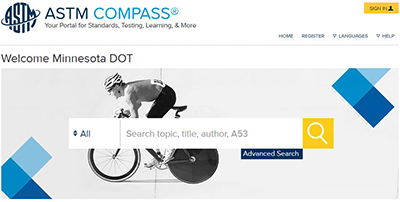
This is the homepage of ASTM DOT Compass Portal, where you can search by keyword, title, or standard/spec designation. |
MnDOT Library is pleased to announce the continuation of the ASTM DOT Compass Portal (https://compass.astm.org), an online resource that provides all MnDOT employees with a single point of access to full-text ASTM standards, AASHTO specs, and a small selection of AASHTO books.
During the first year of the Portal’s availability, MnDOT employees accessed or downloaded ASTM and AASHTO documents more than 5,000 times. One application to MnDOT business is that the MnDOT Spec Book contains hundreds of references to ASTM standards and AASHTO specs.
In addition to these standards, the ASTM DOT Compass Portal also offers free e-Learning courses that can earn professional development hours.
Contact the library at 651-366-3791 or library.dot@state.mn.us if you have any questions. The ASTM page on iHUB also has some FAQs. Library staff is available to demonstrate this resource for your office or unit staff meeting. |
 |
|

|
 |
TABLE of CONTENTS
 |
Metro District works with governorís office to start urban youth internship program |
By Rich Kemp
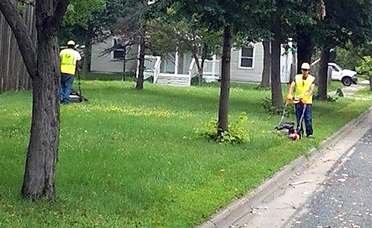
Interns from the Urban Youth Corps mow the grass in the right away in the Twin Cities metro area. The interns assisted the Metro District maintenance crew with mowing, litter pickup and brush removal. Photo by Carey Johnson |
DeWayne Jones, Metro District maintenance manager, thought about his time as a teenager when he came up with the idea for the Urban Youth Corps Internship Program. The program hires youth to help with maintenance jobs that the Metro District doesn’t have the staff to complete.
“When I was growing up in Arkansas, I was able to work a summer job to help pay for my school clothes and take some of the burden off my mom," said Jones.
He talked to Emma Corrie, strategic workforce initiatives director for the Office of Gov. Mark Dayton, about starting a program for youth in the Twin Cities metro area. They lined up partners and got funds from the state and partner organizations to start the UYC.
“DeWayne Jones came up with the idea and we helped connect the dots by finding the right funding and implementation partners to make it happen,” said Corrie. “With our UYC interns, many in their first jobs ever, we are building a basic work ethic, introducing them to new skills, building teamwork and self-esteem.”
UYC is the culmination of a collaboration of several partners. Hennepin County, Project for Pride in Living, BrookLynk, Project Sweetie Pie, Cedar Riverside Opportunity Center, Minneapolis Public Schools and the city of Minneapolis’ StepUp/Achieve program joined the governor’s office and MnDOT to get the program started.
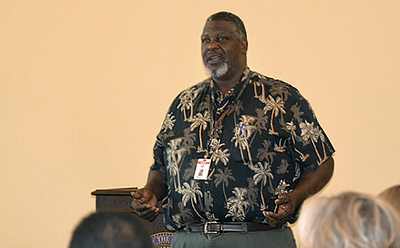
DeWayne Jones, Metro District maintenance, thanked the interns who worked in the Urban Youth Corps Internship Program during a ceremony Aug. 4. Photo by Dana Hernandez |
The program is designed for 15-18 year olds and seven youth were hired for 2017. The youth helped the Metro District maintenance team with mowing, litter pickup and brush removal. The work was completed behind noise walls to keep the youth away from high traffic areas.
“I’m grateful to the many leaders and partners who helped shape the Urban Youth Corps Internship Program into such a success story, including many public and private partners,” said Eric Davis, MnDOT chief of staff. “I particularly want to thank DeWayne Jones, Carey Johnson, Sam White, Diane Dozier and so many other leaders across Metro District who helped supervise, guide and mentor our students to gain valuable on-the-job experience in highway maintenance work.”
The first class of interns were honored during a ceremony Aug. 4 at the State Capitol.
“The governor’s office looks forward to staying involved and growing the number of UYC interns at MnDOT and adding other state agencies next summer,” said Corrie. “Our hope is that, together, we can grow this program next year and into the future, impacting many more 15-18 year olds in our communities.”
Davis said MnDOT is very happy with the results of the first year.
“We look forward to building on the successes of 2017 and growing the program to include as many as 21 students in 2018,” said Davis. “It’s a great way to introduce young talent to careers in state government, while working to maintain our Metro District properties in good and safe condition.” |
 |
|

|
 |
TABLE of CONTENTS
 |
Employees reach out to the ag community at Farmfest |
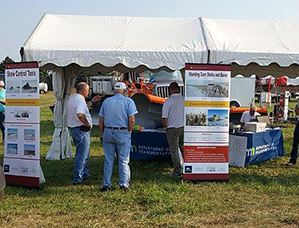 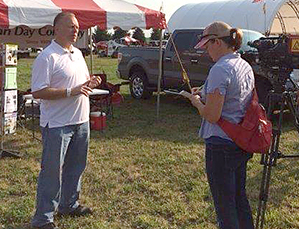
Employees from MnDOT's Office of Environmental Stewardship, Engineering Services, Road Weather Technology, MnCORS, Districts 2, 7, 8 and Metro staffed a booth at this year's Farmfest, held Aug. 1-3 near Redwood Falls. Exhibit staffers covered a variety of topics with visitors stopping by the booth including the current efforts to build consensus about future vegetation management, new road weather technology, snow control efforts and the status of current mowing regulations. (Photo on left) Dan Gullickson, snow control program admin coordinator, Office of Environmental Stewardship, visited with a local farmer about the variety of blowing snow control program options available. Photo by Jed Falgren (Photo on right) Jed Falgren, District 7 assistant district engineer, interviewed with Iowa Public TV producer Colleen Kranz at Farmfest for a future edition of their Market to Market segment that will air in September. Photo by Craig Gertsema |
|
 |
|

|
 |
TABLE of CONTENTS
 |
Aeronautics staff spotlights Minnesota aviation during Oshkosh AirVenture 2017 |
By Mary McFarland Brooks
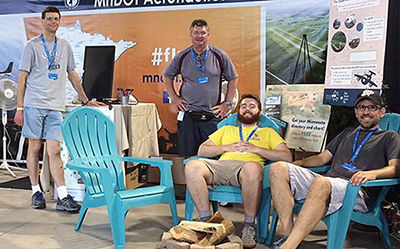
Aeronautics employees (from left) John Fahrendorf, Dan Boerner, Chris Morgan, and Ryan Gaug test the booth layout after setting up on Sunday prior to the show. Photo courtesy of Aeronautics |
More than 590,000 enthusiastic aviation aficionados descended on Oshkosh, Wis. the last week of July for the Experimental Aircraft Association’s 65th annual EAA AirVenture fly-in convention. MnDOT staffed a booth at the fly-in for the second time in several years.
The booth’s theme was #fly.MN and Aeronautics staff engaged visitors by providing photo opportunities with a Paul Bunyan cutout and surveying Minnesota pilots regarding the Minnesota State Aviation System plan. Feedback was also solicited on individual Minnesota airports and collateral materials like directories and travel guides.
Aeronautics’ leadership staff had one-on-one meetings with several organizations at the event:
- Aircraft Owners and Pilots' Association
- National Business Aviation Association
- Federal Aviation Administration
- Recreational Aviation Foundation
- National Association of State Aviation Officials
The number of visitors to the MnDOT booth who took photos and received airport information numbered several hundred daily. As these same visitors shared their iconic photos on social media, other people responded by also visiting the MnDOT booth. The Aeronautics Office is also recruiting for an open position in their office and several AirVenture attendees applied.
Photos taken at the aeronautics booth were shared daily on MnDOT’s Instagram and Facebook sites. Social media overall played a big part in the convention with a confirmed reach of more than 15.4 million people by AirVenture’s social media channels during the week.
More than 75,000 people attended at least one of the more than 1,000 forums held at the convention. In addition to staffing the booth, aeronautics staff attended technical forums on a wide array of aviation issues and staff successfully recruited new businesses to exhibit and/or speak at the annual maintenance conference hosted in partnership with the Association for Women in Aviation Maintenance.
“The combination of great weather and eager and engaged attendees contributed to a very successful event,” said Cassandra Isackson, Office of Aeronautics director.
The fly-in has significant international reach with more than 80 nations represented. The countries with the most attendees included Canada, Australia and South Africa. The total number of international visitors was more than 2,527, which did not reflect the 750 media representatives on-site from six continents.
The 40,000 convention attendees who filled the adjacent campgrounds, created the second largest city in Winnebago County, with Oshkosh city being the largest. The grounds crew and volunteers welcomed more than 10,000 aircraft at Wittman Regional Airport in Oshkosh and other airports in eastern central Wisconsin.
The number of show planes at the event increased 5 percent from 2016 for a total of 2,991, while vintage airplanes at EAA grew by the same percentage to 1,162. One of this year’s highlights was two B-29 bombers flying formation as part of showcasing 75 years of bombers on parade.
Next year’s festival runs from July 23-29. Buoyed by their 2017 successes, MnDOT’s Aeronautics staff plans to also have a presence at the 2018 conference. |
 |
|

|
 |
TABLE of CONTENTS
 |
Cameras help MnDOT monitor road conditions, manage traffic |
By Stephanie Smith-Christensen, District 1 public affairs

Traffic detection cameras, like these at Trinity Road and Anderson in Duluth, are typically mounted on traffic lights. Their sole purpose is to detect traffic and activate the lights to change. Photo by Beth Petrowske |
Most motorists are keenly aware of the numerous street and highway cameras located throughout the state of Minnesota. However, they may not know what these cameras are used for and who is monitoring them. There are just under 2,000 cameras statewide used for one of three functions: Road Weather Information Station, traffic detection and traffic management.
RWIS cameras are primarily located in rural areas that lack communications infrastructure. Throughout the state there are 86 different sites where RWIS cameras can be found. They cannot be remotely repositioned, and they do not capture ongoing video.
“Rather than continuously recording footage, RWIS cameras are pointed at specific locations and designed to capture still shot images which upload every few minutes,” according to John McClellan, traffic operations supervisor for the Regional Transportation Management Center in Roseville. The data is then used by maintenance crews to remotely determine road and weather conditions, and decide if plow crews should be dispatched to those areas.
More numerous, and more frequently confused by drivers, are the state’s traffic detection cameras. These cylinder-shaped cameras are typically mounted on traffic lights and pointed towards cars. There are approximately 1,000 detectors throughout the state, particularly at intersections where there are turn lanes. Contrary to popular belief, these cameras are not being remotely controlled either, and they cannot zoom in to look at vehicles more closely. Additionally, they are not designed to take photos or enforce traffic violations.
“In truth, no one is watching these cameras at all,” said McClellan. “Their sole purpose is to detect traffic and activate the lights to change.” At other intersections where there are no cameras, underground u-coils are embedded in the road’s surface to trigger changing lights.
Traffic management cameras are ones typically located in higher volume areas such as highways and busy intersections. There are about 900 statewide, the majority of which are located in the Twin Cities metro area. Unlike the RWIS cameras, they require a communications infrastructure to support the transfer of video data. They are also able to move in different directions and are used to monitor road conditions, traffic patterns and traffic density.
Additionally, they are used by enforcement officials to identify stalls and crashes, or focus on locations where incidents frequently occur. These cameras are equipped with radar detection. In the event of an incident, the radar can be used to determine a vehicle’s speed prior to the crash; however, radar is not used to enforce traffic laws.
“Most traffic cameras were installed in the 1990s, and the footage is often grainy. It is not clear enough that license plates can be distinguished,” said Dave Mavec, District 1 senior traffic engineer.
All camera footage is public data, and is typically retained for 48 hours. To get personalized alerts, weather updates, or view camera information and traffic speeds, visit www.511mn.org/. |
 |
|

|
 |
TABLE of CONTENTS
 |
Collaboration, creativity wins 2017 State Government Innovation Award |
By Judy Jacobs
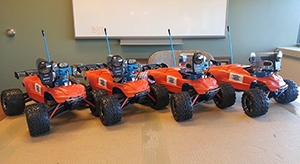
District 6 shared its expertise with several other MnDOT districts by creating and manufacturing HIVEs for statewide use. Photo by Mike Dougherty |
On July 27, the Bush Foundation and the Humphrey School of Public Affairs recognized and awarded two MnDOT initiatives for the State Government Innovation Award. The award acknowledges the great work that state agencies do and encourages them to offer better products and services to the public they serve. The awards are based on creativity, collaboration and efficiency.
Statewide Air Quality Index Forecasting
This innovative partnership with the Minnesota Pollution Control Agency and the Department of Health launched a new statewide air quality control index forecasting program. This partnership allowed PCA to expand from two forecast locations to 17, allowing Minnesota residents a better way to plan their outdoor activities. Air quality alert messages include specific messages that residents can take to reduce their exposure during times of poor air quality.
MPCA meteorologists used artificial intelligence, automated weather prediction and their expertise to create statewide AQI forecasts statewide. Bringing this expertise in-house saved the agency about $50,000 in external forecasting fees.
PCA collaborated with MnDOT and the Minnesota Department of Health to improve the alert messages, disseminate the messages through each agencies’ existing media and employee distribution lists and social media outlets.
Hydraulic Inspection Vehicle Explorer
MnDOT’s District 6 personnel developed a radio-operated car modified with lights and a video camera that sends images to a tablet held by an inspector. The HIVE device uses off-the-shelf hobby shop equipment to provide the needed data for managing the pipes and culverts under, and adjacent to, the state’s highways. District 6 employees have built similar machines for other MnDOT districts.
“We’re honored that a device that has improved out effectiveness and efficiency has been able to be shared with other MnDOT districts,” said Jeff Vlaminck, District 6 transportation district engineer. “The HIVE idea came from our inspector, who worked with others in District 6 to refine and improve it for performance in the field.”
To read more about these and other award winners, check out the 2017 State Government Innovation Awards website. |
 |
|

|
 |
TABLE of CONTENTS
 |
MnDOT addresses climate change, sustainability |
By Commissioner Charlie Zelle

Commissioner Charlie Zelle drives one of MnDOTís electric vehicles. Photo by David Gonzalez |
Climate change is already occurring in Minnesota and MnDOT is adapting transportation infrastructure to reduce disruptions to the movement of people and goods within the state.
In 2016, transportation overtook electricity generation as the number one source of greenhouse gas emissions in the United States. In Minnesota, transportation remains the number two source, but that will change as utilities move forward with planned increases in renewable energy generation.
This year MnDOT published its first sustainability report. This report establishes a baseline to evaluate future progress on sustainability and will support decision making. It aslo establishes agency sustainability goals around greenhouse gas mitigation, climate adaptation, resource efficiency, chloride reduction and enhancing pollinator habitat.
Minnesota Statute § 216H.02, legislated the Next Generation Energy Act that set GHG reduction goals of 15 percent by 2015, 30 percent by 2025, and 80 percent by 2050, compared to 2005 GHG emissions. In Minnesota, MnDOT is the first state agency to formally apply the goals agencywide to fleet fuel use, facility energy use, the highway construction program and to the transportation sector as a whole. The report also establishes the most aggressive GHG reduction goals for any state department of transportation in the country. Strategies to achieve these goals focus on lifecycle costs and benefits to the state.
The MnDOT Sustainable Transportation Steering Committee was formed in 2016 to provide leadership, strategic direction and oversight for agency sustainability activities. MnDOT uses a ‘triple bottom line’ vision to make agency decisions that maximize the health of people, the environment and the economy. MnDOT plays a critical role in reducing greenhouse gas emissions and preparing for climate change. While MnDOT manages about 10 percent of all Minnesota roadways, the agency plays a larger part in influencing statewide policy and decision making.
Minnesota has a history of being a national leader on climate and transportation issues. This ongoing effort helps maintain that role. The report is exciting because it captures some of the innovative work MnDOT is already doing and will serve to provide guidance for more sustainable practices in the future.
Thank you for your part in driving this progress forward.
Fleet offers electric vehicle options
By Josh Pansch, Office of Environmental Stewardship
Central Office has a new car in the fleet that is charged up and ready to roll. A 2017 Chevy Bolt electric vehicle is now available for use by all MnDOT employees.
This electric vehicle uses no gas and relies on a battery that gives the car a 238-mile range. Using this vehicle will save fuel costs as well as benefit the environment.
Based on estimates from the U.S. Department of Energy, using an electric vehicle reduces greenhouse gas emissions by about half that of a gasoline vehicle. The Bolt is perfect for trips around the Twin Cities area, and can even be used for trips to Duluth, Rochester or St. Cloud when charged during your stay.
The Bolt will be fully charged when you pick it up from the garage. Driving the vehicle is similar to any other car if you don’t need to charge it. A computer on the vehicle tracks your battery usage and notifies you when your battery is getting low. There are instructions in the owner’s manual on how to charge the vehicle. If you’d like to use it for a longer trip please work with the motor pool to get charging instructions or visit the Sustainablity website on iHub and check out the “How to” video that provides helpful hints about how to operate this new electric vehicle.
MnDOT is still working on getting access to fast chargers located around the state. For now, if you want to use the Bolt for a trip outside the Twin Cities area, make sure to locate a fast 240-volt level 2 or DC fast charger charging stations in advance. As a reminder, Level 2 charging will give you about 25 miles per hour of charge.
Instructions to charge the vehicle are included in the owner’s manual in the passenger’s side glove box. Public chargers will have instructions and a cable included. |
|
 |
|

|
 |
TABLE of CONTENTS
 |
Soft skills, engineering expertise, provide solid foundation for public engagement |
By Sue Mulvihill, deputy commissioner and chief engineer

Sue Mulvihill, deputy commissioner and chief engineer, has been involved in a significant variety of public outreach efforts throughout her career. She is a strong advocate of two-way communication to build good working relations with MnDOTís internal, and external, customers.† Photo by David Gonzalez |
Recently I had the opportunity to welcome participants of the Public Engagement workshop held in St. Cloud. I wanted to share with them, and all of you, the value MnDOT’s senior leadership places on all of us becoming experts at using soft skills.
Wikipedia defines soft skills as: a combination of interpersonal people skills, social skills, communication skills, character traits, attitudes, career attributes, social intelligence and emotional intelligence, among others, that enable people to effectively navigate their environment, work well with others, perform well and achieve their goals with complementing hard skills.
MnDOT has often been called an “engineering organization.” When I think about all of the amazing projects we’ve done over the years, I know they are the direct result of solid, innovative, engineering skills. But, we cannot forget the soft skills that also helped build that legacy.
The work we do at MnDOT touches everyone in Minnesota. It’s important to find that balance of technical expertise and the soft skills we need to listen, understand and respond to customer needs (both our internal and external customers). We need to put as much emphasis on listening to our customers and learning about their needs as we do with our technical and engineering work on roads, bridges and other modes of transportation.
WIG 2.0 is helping us shift our culture. WIG 2.0 challenges us to improve intentional customer engagement to build customer trust. That’s where we can use our soft skills to change our culture from that of a producer mindset to one of a customer mindset and think about things from the customer perspective.

Sue Mulvihill, deputy commissioner and chief engineer, spoke at the public engagement workshop May 15 about soft skills. Photo by Chris Joyce
|
As state employees, we all need to apply these soft skills to focus on the public we serve. We know Minnesotans want to be part of the process in decisions that affect their communities. As MnDOT employees, we all have a stake in the success of our public engagement efforts. How do we engage our customers? What are their needs? How do we most effectively address their concerns?
MnDOT employees work hard to plan, build, operate and maintain the state’s infrastructure. I want to thank you for all your hard work, for your efforts to engage the public and for your work to build partnerships and advance equity. It’s a privilege to work with you on this journey to earn customer trust.
For more information about how you can get involved in the WIG 2.0 priority to Improve Intentional Customer Engagement, read WIG co-champion, Tim Henkel and Mitch Rasmussen’s overview. For more information about MnDOT’s 2017 Public Engagement Strategic Plan, click here. |
 |
|
| |
|



